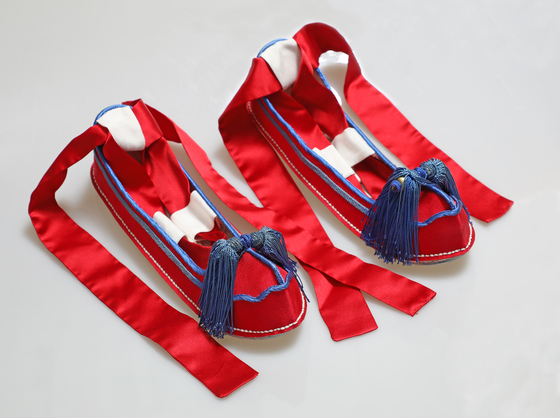6대째 이어 온 가업 지키는 전통 신 장인
![Hwang Duck-sung works on a traditional Korean shoe at his workshop located in Macheon-dong, Gangdong District, eastern Seoul. He has been making traditional Korean shoes for six generations. [PARK SANG-MOON]](https://koreajoongangdaily.joins.com/data/photo/2024/04/12/83974854-65bf-4a27-b0e8-736dab61273d.jpg)
Hwang Duck-sung works on a traditional Korean shoe at his workshop located in Macheon-dong, Gangdong District, eastern Seoul. He has been making traditional Korean shoes for six generations. [PARK SANG-MOON]
After six generations, traditional Korean shoemaker keeps family practice alive
6대째 이어 온 가업 지키는 전통 신 장인
Korea JoongAng Daily 10면 기사
Friday, April 5, 2024
Kkotsin, which roughly translates to flower shoes, is the most well-known among traditional Korean footwear. The silk shoes are adorned with embroideries of 10 traditional symbols of longevity such as the sun, the moon and deer as well as apricot flowers and peony blossoms. Their beauty lies in their slightly curved, upturned tips, just like the curves found on the roofs of hanok, or traditional Korean houses. Each shoe is identical, with no distinctions between the left and the right — but they conform to the shape of the wearer's feet.
footwear: 신발류, 제화
adorned with: ~로 꾸미다
embroidery: 자수
longevity: 장수
apricot flowers: 매화
peony: 모란, 작약
blossoms: (봉오리가 다 열린) 꽃
upturned: 위로 향한
conform: ~에 순응하다. ~에 일치하다
대략 ‘꽃 신발’로 번역할 수 있는 꽃신은 한국의 전통 신발 중 가장 널리 알려져 있다. 비단 신발에 해, 달, 사슴 등 십장생이나 매화나 활짝 핀 모란 수를 놓아 꾸민다. 꽃신의 아름다움은 마치 한옥 처마처럼 살짝 곡선을 그리며 날렵하게 올라간 코에 있다. 왼쪽과 오른쪽이 차이 없이 똑같지만, 신는 사람의 발 모양에 맞게 변한다.

The official name of traditional Korean shoes is hwahye. Hwa are high shoes covering the ankles, and hye are low-cut shoes that do not cover the ankles. Hwa and hye were used separately in the past, but now the two are combined as one word to refer to all sorts of footwear. Hwahyejang, or gatbachi, are shoemaking masters are people who produce hwahye.
ankle: 발목
all sorts of: 다양한 종류의
한국의 전통 신의 정식 명칭은 화혜(靴鞋)다. ‘화’는 발목까지 오는 긴 신발을 뜻하고 ‘혜’는 발목을 덮지 않는, 목이 없는 신발을 뜻한다. 과거엔 화와 혜를 구분해 따로 썼다. 현재는 이 둘을 하나의 단어로 묶어 다양한 종류의 신발을 일컫는다. 화혜장 혹은 갖바치는 화혜를 제작하는 신발 장인이다.
Hwang Duck-sung, 45, has been making traditional Korean shoes for six generations. He follows his father Hae-bong. Jong-su, Duck-sung's great-great-great-grandfather, initiated the family business, making and providing leather shoes to King Cheoljong, the 25th ruler of the Joseon Dynasty (1392-1910). Duck-sung’s great-grandfather, Hangap, was the last shoemaking master of the Joseon Dynasty, crafting red shoes that Emperor Gojong wore on special occasions.
initiate: 시작하다, 세우다
family business: 가업
craft: 공예품을 만들다
황덕성(45)씨는 6대째 한국의 전통 신을 만들어 오고 있다. 그는 아버지 황해봉의 뒤를 잇는다. 덕성씨의 5대조 할아버지 황종수가 조선 제25대 왕 철종 때 왕실에 가죽신을 납품하며 가업을 세웠다. 그의 증조할아버지 황한갑은 조선왕조의 마지막 화혜장으로, 고종 황제가 특별한 의례때 신었던 붉은색 신발, 적석을 만들었다.
Hae-bong was dedicated to reproducing traditional Korean shoes, which were on the verge of disappearing. That was a difficult task, as the Joseon Dynasty saw more than 20 types of footwear, and only documents recorded their existence. Nevertheless, he restored the blue and red shoes that were worn by kings and queens of the Joseon Dynasty alongside experts in traditional garments.
dedicated to: ~에 전념하는
reproduce: 재현하다
on the verge of: ~의 직전에
restore: 복원하다
garment: 의복
황해봉씨는 사라질 위기에 처한 전통 신을 재현하는데 전념해 왔다. 조선시대 신발의 종류가 20가지가 넘고, 오직 문헌에만 남아있었기 때문에 쉽지 않은 일이었다. 그럼에도 불구하고 그는 복식 전문가들의 도움을 받아 왕과 왕비가 의례 때 신던 적석과 청석을 복원했다.
Duck-sung, who had grown up watching his father work on the forgotten royal shoes, decided to commit himself to the family business, which he thought was valuable and meaningful. Even when he was a teenager, he was proud of his father.
commit oneself: 다짐하다
valuable: 가치 있는
잊혀진 왕실 신발을 복원하는 아버지의 모습을 보면서 자란 덕성씨는 자신도 이처럼 가치 있고 의미 있는 가업을 이어갈 것을 다짐했다. 10대 시절에도 그는 아버지를 자랑스러워 해왔다.
WRITTEN BY PARK SANG-MOON AND TRANSLATED BY YIM SEUNG-HYE [park.sangmun@joongang.co.kr, yim.seunghye@joongang.co.kr]










with the Korea JoongAng Daily
To write comments, please log in to one of the accounts.
Standards Board Policy (0/250자)